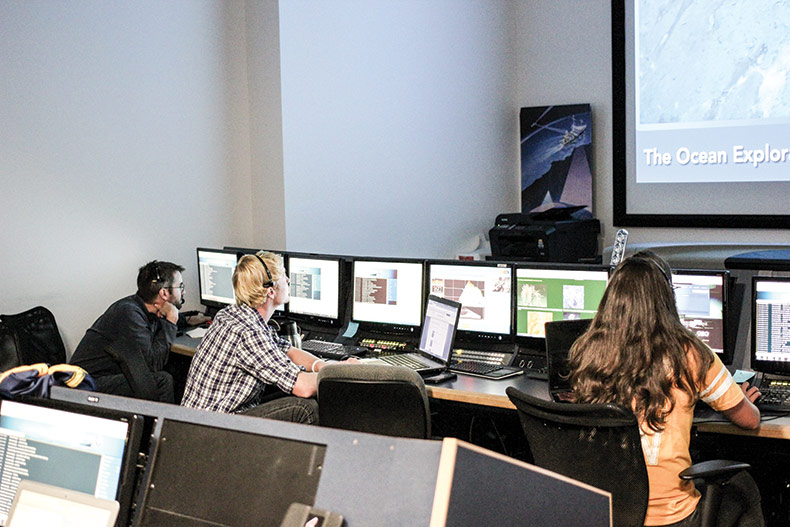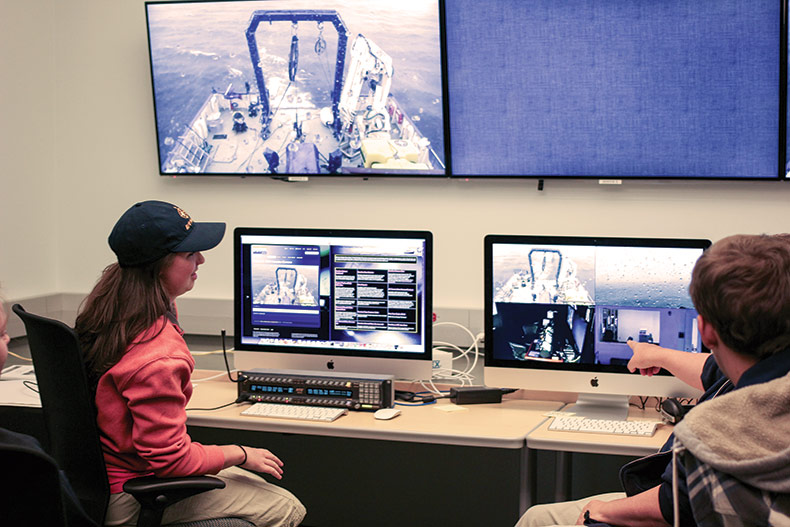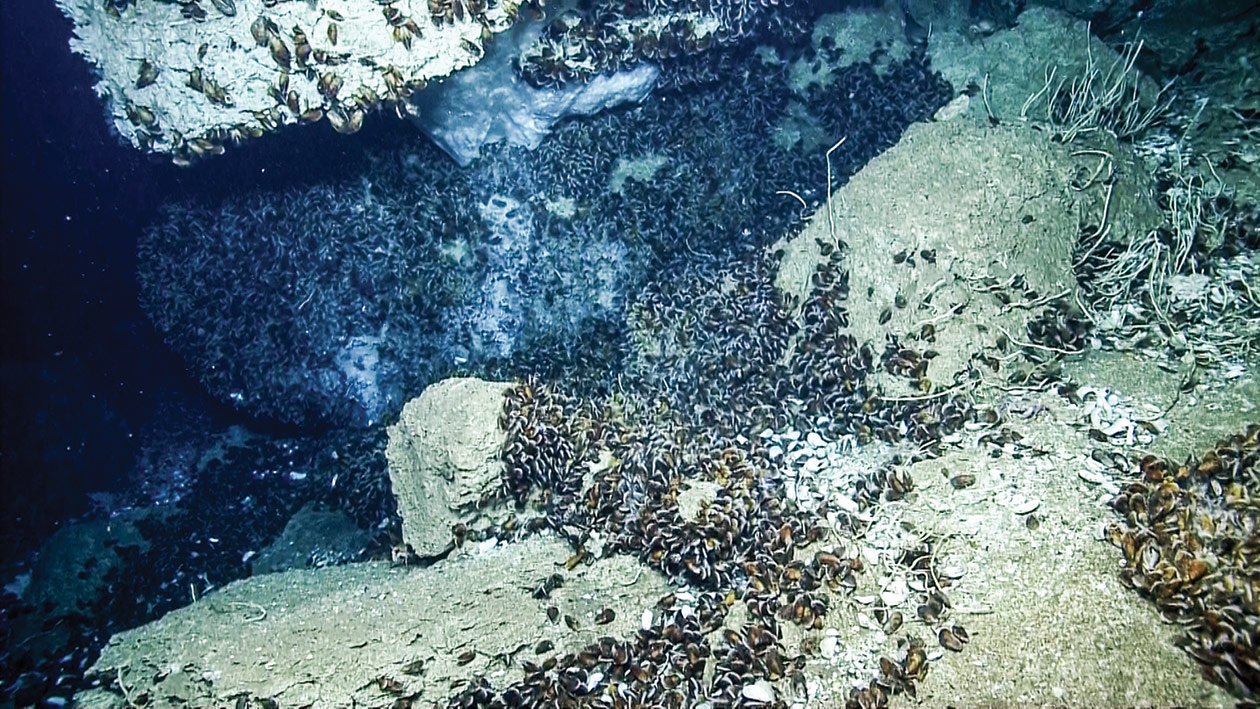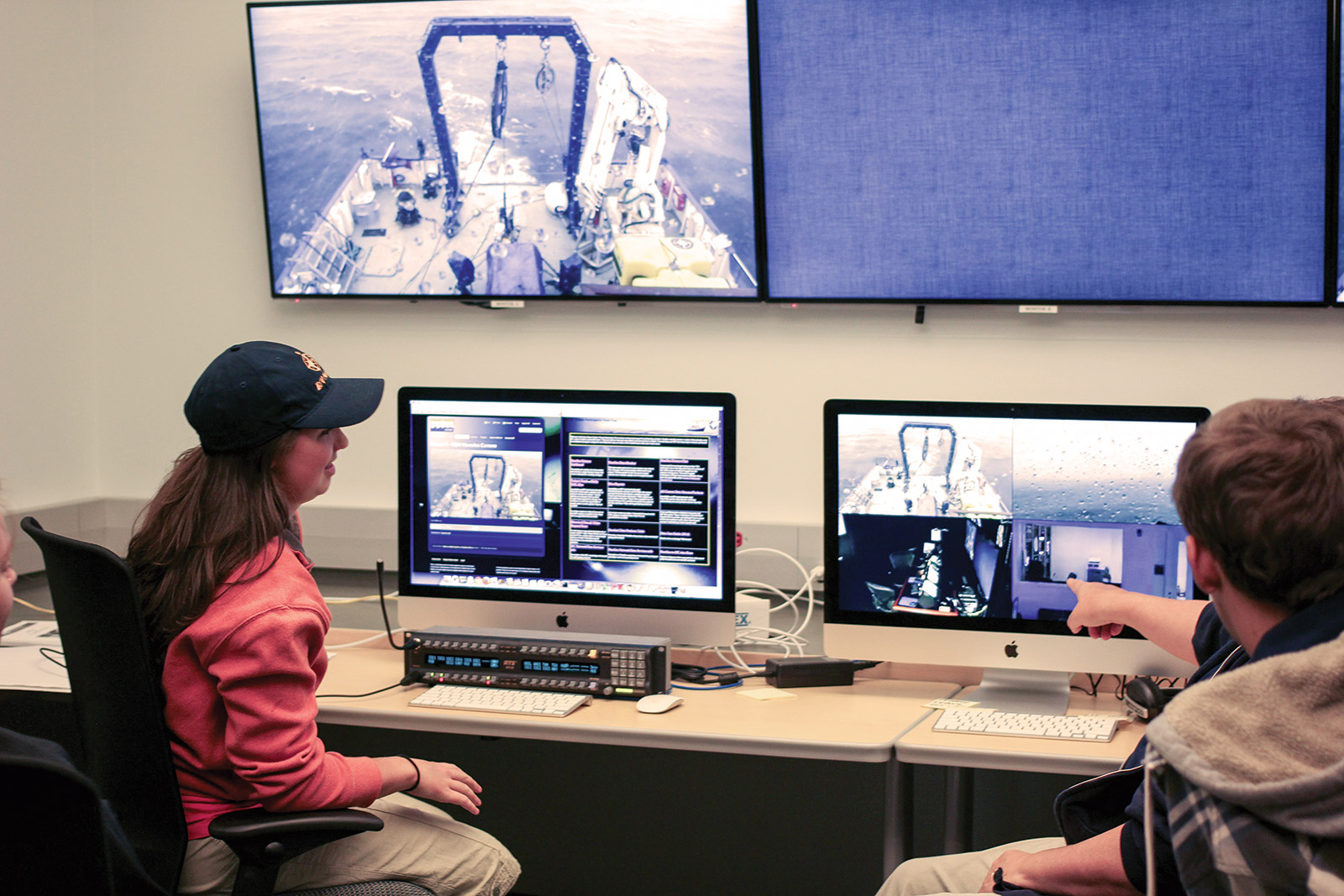From Ship to Shore: Telepresence Research
In September of 2014, the E/V Nautilus set sail to collect data and explore research sites in the Caribbean, including the Kick’em Jenny seamount, the adjacent cold seeps and the Barbados mud volcanoes. On board the ship was the regular cast of characters—scientists, ROV (remotely operated vehicle) pilots, engineers, public communicators and the crew. At the same time, another group of scientists and undergraduate students arrived at the University of Rhode Island’s Inner Space Center (ISC), where they were trained by ISC staff on communication and video technology operations to help guide the ocean research.
As part of the National Science Foundation-funded Transforming Remotely Conducted Research through Ethnography, Education and Rapidly Evolving Technologies (TREET) project, this cruise was challenged to use telepresence to transform the way oceanographic research and education is done. The ISC is designed to provide technical support for research expeditions. But coordinating a two-week cruise in which many of the decision makers are directing activities remotely from the ISC was unusual. Another unique aspect of this expedition was the inclusion of undergraduate students. Though they had never been on a research cruise, the students were collecting data to complete their own research projects.


On any cruise, teams work together around the clock, and this project replicated that schedule on board and on land. On board, a constant rotation of watch standers included four people in the command center responsible for directing the ship, the ROV, and the data and video collection. Additionally, there were watch standers at the ISC, including a chief scientist, a research scientist and two undergraduate students per shift. All work was coordinated between the ship and shore groups through satellite video feeds and radio communication technology.
Regardless of location, participants on watch analyzed live video feed from the ROV, developed mapping and data collection plans, and recorded all observations to a science chat area. With two separate locations, the expertise on any given watch was distributed. Sometimes the knowledge base was with a scientist sitting beside the ROV pilot and at other times it was with a scientist or student thousands of miles away at the ISC.
Change in the workflow
Attempting to recreate the shipboard culture on land, watches mirrored the work in the command center aboard the Nautilus (though the times were slightly askew with four-hour shifts on ship and six-hour shifts on shore). A daily conference call was set up, in place of a shipboard meeting, for all participants to discuss plans for the dives. Data was collected and sent to shore (when practical, based on what data could be sent via satellite) so participants not on watch could use it for planning purposes. The idea was for everyone to be immersed in the work and schedule of the ship as much as possible. For those on shore, however, this proved harder than expected. Day-to-day life—from other activities at the ISC to calls and emails from respective work and school institutions—was distracting. Although the ISC is equipped with floor-to-ceiling monitors that provided remarkable seafloor views from the ROV and the ship, it was nevertheless difficult to shift to the 24-hour workflow of the ship, even from one of the most technologically advanced remote sites.
Similarly, those on the ship had a hard time grasping what was happening on land, and an even harder time trying to communicate to shore about things that were not visible via the video feed, like the ocean currents that sometimes made it difficult to navigate or the changing weather and sea conditions. But most importantly, it was a new experience to have decisions regarding data collection and mapping choices being made in different places. With such a complex system, there was occasional confusion in communications.
Undergraduate opportunities
One of the project goals was to include undergraduates as authentically as possible in the research community. Typically, if scientists procure money and a berth on a ship, they can bring a student on board. In ocean science that’s usually a graduate student familiar with the professor’s research interests and with the data collection and analysis tools. But with fewer—and smaller—research ships available, opportunities for students to get involved in fieldwork are limited. This project set out to show that with the use of telepresence, undergraduate students could share in these opportunities, and that their inclusion would be most engaging if they conducted their own research. And it worked! Students were involved in daily cruise maneuvers, and more importantly, in making sure that the data they were interested in was collected.
Three early career scientists—from Harvard University, Michigan State University and the University of Idaho—recruited seven students to participate in the cruise from the ISC. These scientists were responsible for mentoring students as they developed research proposals; helping students get a feel for the ship environment; explaining how things work on the ship; and guiding data collection at the research sites. Students began by conducting and recording observations, and were later able to guide the data collection necessary for their own research. They told the Hercules pilot where to navigate the ROV, helped design mapping routes and made suggestions about what samples to collect at the different sites. While their choices and directions could not always be carried out exactly as planned, both the ship-based and shore-based scientists helped solve issues and mentor the students.
Unexpected outcomes

This telepresence cruise showed that while you can’t exactly recreate the experience of being on a ship, it is possible to offer a similar though unique experience from shore. Students and scientists alike at the ISC were engaged in ensuring data and samples were collected for everyone’s research needs. One student described his experience: “I came up with my dive plan and was pretty stoked …was talking back and forth with the scientists about my research and feel good.” Another said, “I did some important bubble imaging and photo mosaic-ing today and feel much better about my project.” Everyone left the cruise knowing that there were data and samples to begin their analysis.
The overall experience was different, however, depending on location. For example, it was hard for ship scientists to remember that there were scientists and students on shore who were equally invested in the outcome of the cruise. It was hard for shore crew to work overnight and try to sleep during the day, when the world around them was out of sync with their schedule. And it was hard for scientists in general to let students take leadership roles. At the same time, it was amazing to witness the confidence of young students helping to make research decisions, especially given that the research sites were thousands of miles away and visible to them only through video feeds and by the technology of telepresence.
Change is hard. Changing a well-established culture is even harder, but this project revealed what it might take, and highlighted some potential next steps to transform oceanographic research and education.
Amy Pallant (apallant@concord.org) directs the TREET education research.
This material is based upon work supported by the National Science Foundation under grant OCE-1344250. Any opinions, findings, and conclusions or recommendations expressed in this material are those of the author(s) and do not necessarily reflect the views of the National Science Foundation.

